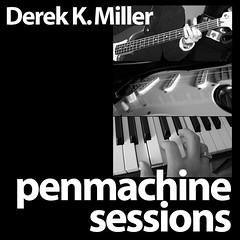How to reduce background noise in podcasts and other live audio
Permalinks to this entry: individual page or in monthly context. For more material from my journal, visit my home page or the archive.
On a mailing list that Chris Pirillo runs, Vancouver blogger and conference organizer Darren Barefoot asked how to reduce the background noise he was getting when recording interviews with a setup that included nice unidirectional microphones and a compressor. Here's my response:
I'm writing here as a musician, not someone who records talk-show-style podcasts (I do have a podcast, but it's purely instrumental tunes for now—see below), but I've dealt with a lot of vocal recording, so this may still be informative.
- One of the problems may be the compressor. Keep in mind that what a compressor does is reduce the dynamic range of your recording—it makes the loudest parts quieter, and the quieter parts louder. One of the quieter parts being background noise and hum. Depending on what you're doing with the compressor, that may be contributing to the noise level. See this page for some background on compressors and limiters (compressors that only lower the volume of the loud bits), and a little rant I did last year about how compression is overused these days (although it is certainly helpful when recording very peaky, dynamic stuff like speech).
- A strongly unidirectional ("supercardioid" or "hypercardioid") mic with one of those foam windscreens will certainly help. You may already be using one of those, but the longtime standard is something like the Shure SM58, common on concert stages and podiums around the world. There are more expensive, more dedicated, highly directional microphones like those used by TV crews. Other options are lavalier (tie-clip) mics and headsets, which put the microphones closer to the speakers' mouths, and thus block out much more background noise.
- Is the mixer powered, or is it running off the iBook's USB port or something? It would be better if it has its own power.
- Consider a small power conditioner for when your laptop and recording gear is plugged in. Musicians use those in rack systems to reduce hum and noise from dirty power or bad power wires. Oh, and turn off your wireless Internet, cell phone, and other radio transceivers, as well as microwave ovens, fridges, and cordless phones (which you may need to unplug) nearby to try to reduce induced radio noise. That may be overkill, but every bit helps.
- The room is important, more so than almost anything but the mic. There's a reason radio studios (including those portable trailer ones) have all that foam on the walls, and big thick doors and multi-paned windows. It's also why on-location radio shows (onstage at theatres, outdoors, at shows and in vehicles) sound so noisy, with everyone more prone to shouting, even when using the same high-end gear from the radio station. Lots of hard surfaces, fans, traffic, audience members, and so on will increase the noise level. So if you're recording a podcast on location, find the quietest, most carpeted room you can, and try sitting on soft chair away from big boardroom tables or other reflecting surfaces to reduce echoes.
- Finally, get the mic as close as possible (but not too close—10 cm away is good) to the mouth of whoever's speaking at the time. If you can have two mics, one each for the interviewer and interviewee, or one for each member of a panel, that reduces the extra noise and awkwardness of flipping the mic head back and forth or having to pass it among the group.
With luck, you'll end up with audio that requires minimal post-processing.
David Lawrence added this as further advice:
And so, one of the ways you can ameliorate the noise is by using a mic processor that also includes an expander. This processes the sound in the complete inverse of a compressor - it exands the dynamic range, making loud sounds louder and soft sounds softer. You might think that the two cancel each other out, but they do not. In combination with a noise gate, which shuts the inputs off to the microphone when the sound level drops to an adjustable volume, these three processes can make the noisiest area a lot quieter.
I use several different mic processors, but the one that I usually come back to and specify for clients is the Symetrix 528E. EQ, compression, de-essing, expansion, phase correction - it's the box people want.







